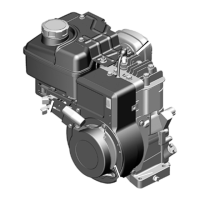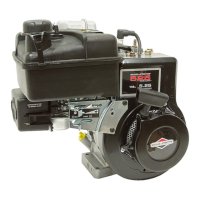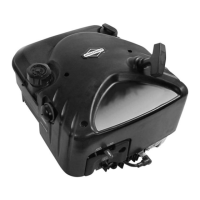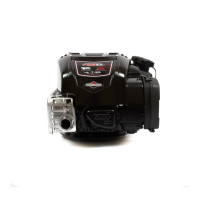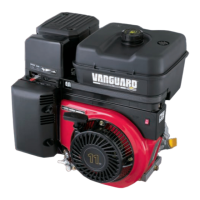GB
3
Oil Recommendations (see fig. )
Engine shipped from Briggs & Stratton without
oil.
Before starting engine
, fill with oil. Do not over-fill.
Use a high quality detergent oil classified For Service
SF, SG, SH, SJ" or higher such as Briggs & Stratton
30W, Part Number 100005. Use no special additives
with recommended oils. Do not mix oil with gasoline.
Choose the SAE viscosity grade of oil from this chart
that matches the starting temperature anticipated be-
fore the next oil change.
Note: Synthetic oil meeting ILSAC
GF-2, API certification mark and API ser-
vice symbol (shown at left) with SJ/CF
ENERGY CONSERVING" or higher, is an
acceptable oil at all temperatures. Use of
synthetic oil does not alter required oil
change intervals.
* Air cooled engines run hotter than automotive en-
gines. The use of non-synthetic multi-viscosity oils
(5W-30, 10W-30, etc.)in temperatures above 40° F
(4° C) will result in higher than normal oil consump-
tion. When using a multi-viscosity oil, check oil level
more frequently.
** SAE 30 oil, if used below 40° F (4° C), will result
in hard starting and possible engine bore dam-
age due to inadequate lubrication.
Check oil level. (Oil capacity is about 20 oz. or 0.6 liter.)
Place engine level and clean around oil fill
.
Remove dipstick, wipe with clean cloth
, insert and
tighten down again. Remove dipstick and check oil lev-
el. Oil should be at FULL mark
.
If oil is required, add slowly. Tighten dipstick firmly be-
fore starting engine.
Do not overfill. Overfilling with oil may cause:
1. Smoking,
2. Hard starting,
3. Spark plug fouling,
4. Oil saturation of air filter
Fuel Recommendations
Use clean, fresh, lead-free, regular gasoline with a
minimum of 77 octane. Leaded gasoline may be used if
it is commercially available and if unleaded is unavail-
able. Purchase fuel in quantity that can be used within
30 days. See Storage.
In U.S.A. leaded gasoline may not be used. Some
fuels, called oxygenated or reformulated gasolines, are
gasolines blended with alcohols or ethers. Excessive
amounts of these blends can damage the fuel system
or cause performance problems. If any undesirable op-
erating symptoms occur, use gasoline with a lower per-
centage of alcohol or ether.
This engine is certified to operate on gasoline. Exhaust
Emission Control System: EM (Engine Modifications).
Do not use gasoline which contains Methanol. Do not
mix oil with gasoline.
For engine protection, we recommend using Briggs &
Stratton Fuel Stabilizer available from an Authorized
Briggs & Stratton Service Dealer.
Check fuel level.
Before refueling, allow
engine to cool 2 minutes.
Clean around fuel fill before removing cap to refuel. Fill
tank to approximately 1 inch below lowest portion of
neck to allow for fuel expansion. Be careful not to over-
fill.
Starting (see fig. )
ALWAYS KEEP HANDS AND FEE
CLEAR OF EQUIPMENT MOVING PARTS.
Do not use a pressurized starting
fluid. Vapors are flammable.
Start, store and fuel equipment in level position.
Check oil level.
Start engine first time
1. Move throttle control to FAST position.
2. Push primer bulb
firmly 5 times.
Close safety brake control handle ,
if equipped. Grasp rope handle and
pull slowly until resistance is felt. Then
pull cord rapidly to overcome com-
pression, prevent kickback and start engine. Repeat
if necessary. When engine starts, operate in FAST
position.
3. If engine does not start after 3 pulls, push primer
bulb 3 times and pull starter again.
Start engine thereafter
1. Move throttle control to FAST position.
2. Push primer bulb
firmly 3 times.
Close safety brake control handle ,
if equipped. Grasp rope handle and
pull slowly until resistance is felt. Then
pull cord rapidly to overcome com-
pression, prevent kickback and start engine. Repeat
if necessary. When engine starts, operate in FAST
position.
Note: If engine stopped because it ran out of fuel, refuel
engine and push primer bulb 3 times
. Priming is usually
unnecessary when restarting a warm engine. However,
cool weather may require priming to be repeated.
Stopping (see fig. )
Release safety brake control handle OR move throttle
control to STOP.
Maintenance (see figs. )
Also, see Maintenance Schedule, next page. Follow
the hourly or calendar intervals, whichever occur first
.
More frequent service is required when operating in ad-
verse conditions.
To prevent acci-
dental starting, re-
move spark plug
wire and ground
it before servicing.
CAUTION:If engine must be tipped to transport equip-
ment or to inspect or remove grass, keep spark plug
side of engine up
.
Transporting or tipping engine spark plug down may cause:
1. Smoking,
2. Hard starting,
3. Spark plug fouling,
4. Oil saturation of air filter.
Oil service
(see fig. )
Check oil level regularly.
Be sure correct oil level is maintained. Check every 5
hours or daily, before starting engine. See oil filling pro-
cedure, Oil Recommendations.
Change oil.
Change oil after first 5 hours of operation. Change oil while
engine is warm. Refill with new oil of recommended SAE
viscosity grade. (see fig.
)
Before tipping engine or equipment to
drain oil, drain fuel from tank by run-
ning engine until fuel tank is empty.
If draining oil from top of engine, keep spark plug
side up.
By removing drain plug
with a ratchet and square ex-
tension
, oil can be drained from engine bottom.
Air cleaner service
(see fig. )
Replace Oil-Foam® element if very dirty or damaged.
• Remove screw.
• Carefully remove air cleaner to prevent debris from falling
into carburetor.
• Take air cleaner apart and clean all parts. Wash Oil-
Foam® element
in liquid detergent and water.
Squeeze dry in a clean cloth. Saturate Oil-Foam® ele-
ment in engine oil and squeeze in a clean cloth to remove
excess oil.
• Install Oil-Foam® element and cup, if equipped, in body.
Note: On Style 2 air cleaner , install element so lip extends
over edge of body to form protective seal when cover is as-
sembled.
• Install air cleaner securely on carburetor with screw.
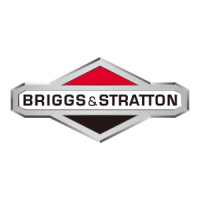
